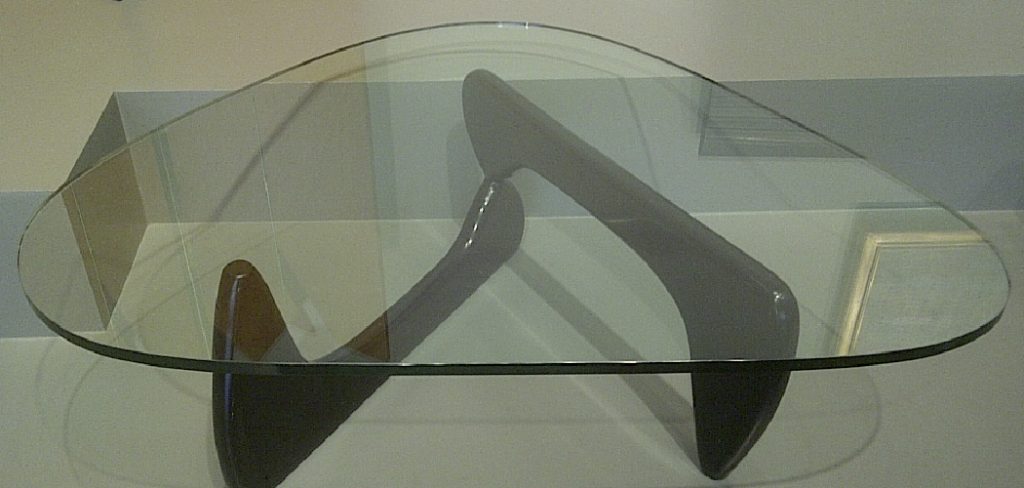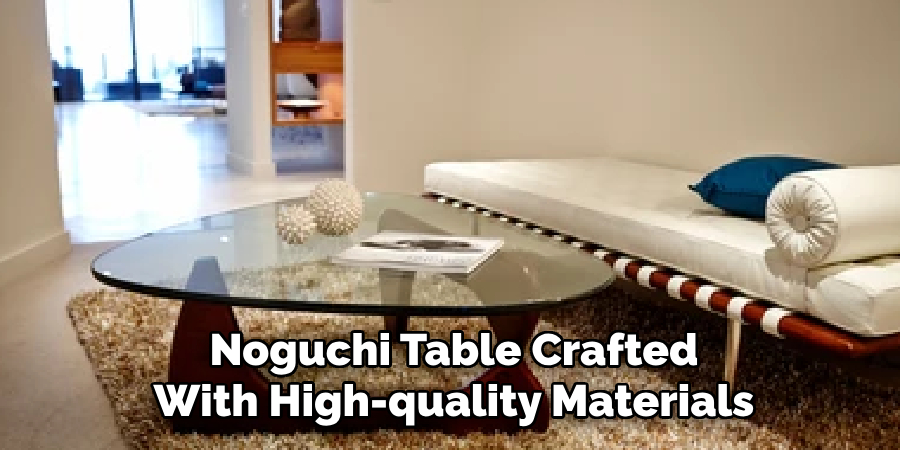Are you looking to buy a Noguchi table but worried about its authenticity? You are not alone. Due to the popularity of this iconic piece of furniture, many replica versions have flooded the market, making it difficult for buyers to identify the authentic ones.
The Noguchi table, an iconic mid-century modern furniture piece, is celebrated for its unique design and timeless elegance. Created by renowned sculptor Isamu Noguchi, this table is both an artistic masterpiece and a functional piece of furniture. However, its popularity has led to countless reproductions and replicas flooding the market, making it essential for buyers to distinguish authentic Noguchi tables from imitations.

How to identify authentic Noguchi table requires a keen eye for details, a good understanding of its design elements, and familiarity with the craftsmanship behind its creation.
What Are the Benefits of Owning an Authentic Noguchi Table?
Before diving into the tips for identifying authentic Noguchi tables, let’s first explore the benefits of owning one.
- Unique Design: The Noguchi table is renowned for its unique design, seamlessly blending organic and geometric elements. The elegantly curved wooden base and glass top create a harmonious balance that adds character and sophistication to any space.
- Timeless Elegance: Despite being designed in 1944, the Noguchi table remains a timeless piece of furniture that fits well in modern homes. Its clean lines and simple yet striking design make it a versatile piece that can complement various décor styles.
- Artistic Value: As a creative masterpiece, an authentic Noguchi table is a functional piece of furniture and a work of art. Owning one means having a conversation starter and a unique statement piece in your home.
- High-Quality Craftsmanship: Each authentic Noguchi table is handcrafted with precision and attention to detail, ensuring its longevity and durability. It’s a testament to the high-quality craftsmanship that went into creating this iconic piece.
What Will You Need?
Before you start your journey to identify an authentic Noguchi table, here are the essential things you will need:
- Reference Images: Familiarize yourself with images of authentic Noguchi tables. This will help you develop a sharp eye for their unique design elements and distinguish them from replicas.
- Knowledge of the Designer: Research about Isamu Noguchi, his background, and his design philosophy. Understanding the designer’s vision can help identify authentic pieces that align with his principles.
- Understanding of Production Techniques: Familiarize yourself with the techniques used to create genuine Noguchi tables. Knowing how these tables are made can give insight into identifying any inconsistencies or flaws in replicas.
- Patience and Attention to Detail: Identifying authentic Noguchi tables requires patience and attention to detail. You’ll need to carefully examine different elements of the table, from its base to its top, to spot any discrepancies that may indicate a fake.
8 Easy Steps on How to Identify Authentic Noguchi Table
Step 1. Examine the Base Material and Design:
The base of an authentic Noguchi table is meticulously crafted to exhibit clean, precise lines and a seamless balance between form and function. Genuine Noguchi table bases are typically made of high-quality wood, such as black walnut, or polished metal, which complements the overall aesthetic of the design. The craftsmanship should be evident in the smooth finishes, natural grain or luster, and the absence of any rough edges or apparent imperfections.

Pay close attention to the interlocking parts of the base—Isamu Noguchi’s design emphasizes harmony and symmetry, meaning there shouldn’t be any misalignments or irregularities. If the base appears overly crude, uneven, or made from substandard materials, this may indicate a reproduction rather than an authentic piece.
Step 2. Inspect the Glass Top:
The glass top of an authentic Noguchi table is a distinctive component, characterized by its thick, curved design and high-quality finish. Genuine Noguchi tables typically feature a heavy glass top that is about 3/4 inch thick, enhancing the table’s stability and durability. The edges should be smoothly polished, demonstrating careful attention to detail. Additionally, the glass should have a slight green tint when viewed from the side—a hallmark of the original design. Any signs of thin, subpar glass or rough, uneven edges may suggest a replica rather than an original Noguchi table. Observing the fit between the glass and the base is essential, as an authentic piece will exhibit a perfect alignment with no awkward overhangs or gaps.
Step 3. Examine the Labels or Markings:
Authentic Noguchi tables often bear specific labels or markings that can confirm their legitimacy. Look for the signature “Isamu Noguchi” engraving or an authentication plaque, usually found on the base of the table. These markings should appear clean, precise, and professionally applied, as opposed to stickers or poorly rendered imitations.
Furthermore, verify the table’s provenance if possible, such as the retailer or manufacturer. Authorized manufacturers like Herman Miller typically produce Authentic Noguchi tables. Any absence of labels or unclear markings could indicate a replica, so ensure all details align with the documented standards of authenticity.
Step 4. Assess the Quality of Materials:
A genuine Noguchi table is crafted with high-quality materials that reflect superior craftsmanship. The base is typically made from solid wood or metal, ensuring durability and a smooth finish. The wooden bases are usually birch, walnut, or cherry, and they exhibit a polished, even grain. The glass top should be thick and heavy, typically ¾-inch plate glass with a polished edge. If the materials feel light, flimsy, or poorly finished, it may signify a counterfeit. Closely inspecting the table for these details can help determine its authenticity.

Step 5. Compare with Official Documentation:
To ensure the authenticity of a Noguchi table, it’s essential to compare the piece with official documentation or reference images. This includes studying catalogs, manuals, or archives provided by authorized manufacturers like Herman Miller. Pay close attention to the proportions, design details, and finishes showcased in the official references. Subtle discrepancies in dimensions or lack of precision in craftsmanship could indicate a replica. Access to legitimate documentation is a valuable tool in confirming the legitimacy of the table.
Step 6. Evaluate Pricing and Provenance:
Another critical step in verifying the authenticity of a Noguchi table is to evaluate its pricing and provenance. Authentic Noguchi tables are premium pieces and are often priced accordingly. Be wary of deals that seem too good to be true, as they could indicate counterfeit or replica items. Additionally, inquire about the table’s history and ownership. Sellers who provide detailed provenance, including receipts, certificates, or records of purchase from authorized dealers, add credibility to the item’s authenticity. Ensuring that the pricing aligns with market standards and confirming its origin are key elements in the authentication process.
Step 7. Examine the Seller’s Reputation:
The seller’s reputation is a crucial factor in determining the authenticity of a Noguchi table. Opt for established dealers, trusted retailers, or individuals with positive reviews and a proven record of selling authentic furniture. Research the seller’s background, ask for testimonials from previous customers, and verify their knowledge about Noguchi tables. A reputable seller will likely provide detailed information regarding the table, its authenticity, and its history. Avoid sellers who are unwilling to answer questions or provide documentation, as this may indicate a lack of authenticity.

Step 8. Inspect the Materials and Craftsmanship:
The materials and craftsmanship of a Noguchi table can reveal a lot about its authenticity. Genuine Noguchi tables are crafted with high-quality materials, such as a thick, durable glass top and a solid wood or lacquered base, depending on the design. The edges of the glass should be smooth and uniform, while the wooden base should showcase precision craftsmanship with no visible imperfections or inconsistent finishes. Pay close attention to the proportions and details, as original Noguchi tables adhere to specific design standards. Beware of poorly made replicas that use subpar materials or exhibit uneven construction. Always compare the table to verified images of authentic Noguchi designs to identify potential discrepancies.
By following these steps, you can confidently determine the authenticity of a Noguchi table.
5 Things You Should Avoid
- Ignoring the Materials: Original Noguchi tables are made from high-quality materials, including a solid wood base and a thick, tempered glass top. Avoid assuming the table is authentic if it uses lighter or cheaper materials that feel less durable.
- Overlooking the Craftsmanship: Authentic Noguchi tables feature seamless craftsmanship with fluid curves and refined details. Be wary of tables with rough edges, poor finishes, or uneven surfaces, as these indicate a replica.
- Neglecting Branding or Documentation: Genuine Noguchi tables often come with a marker of authenticity, such as an etched logo or a certificate. Avoid purchasing a table without verifying these elements, as it could be an imitation.
- Focusing Solely on Price: While a lower price can be tempting, an original Noguchi table usually comes at a premium. Avoid tables priced suspiciously lower than the market average, as they are likely counterfeit.

- Overlooking the Seller’s Reputation: A reliable seller or manufacturer offers transparency about the product’s origins and authenticity. Avoid purchasing from unverified or disreputable sources without proper documentation or proofs of authenticity.
Conclusion
How to identify Authentic Noguchi table requires attention to detail and careful evaluation of its craftsmanship, branding, price, and seller credibility.
By focusing on the quality of materials, seamless design, and verifying authenticity markers like etched logos or certificates, you can avoid falling victim to counterfeit products. Additionally, maintaining vigilance regarding suspiciously low prices and ensuring you purchase from reputable sellers are crucial steps in making an informed decision.
With these considerations in mind, you can confidently ensure that your Noguchi table is a genuine piece of timeless design.

